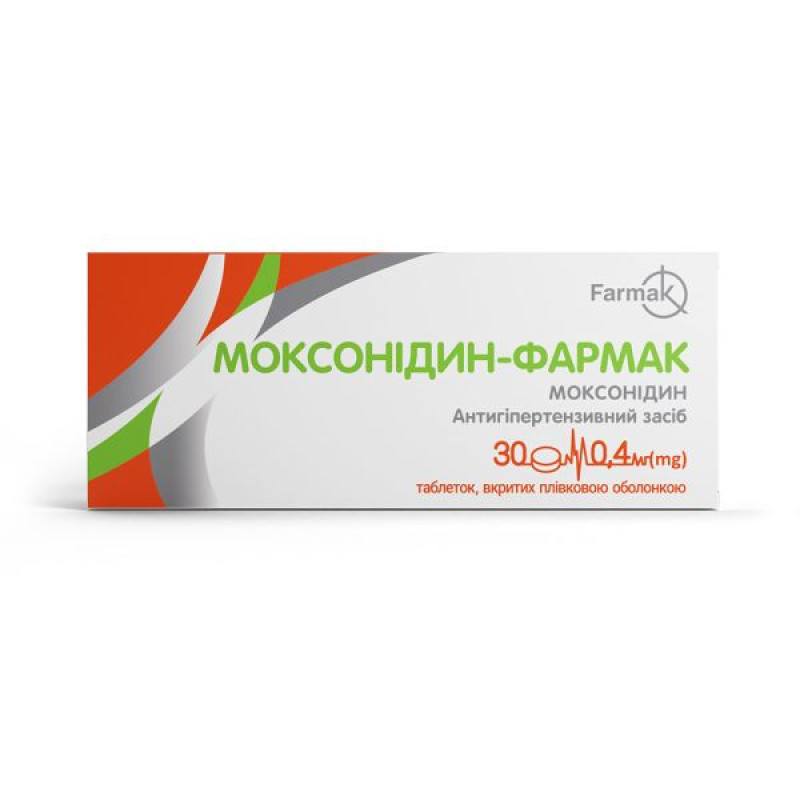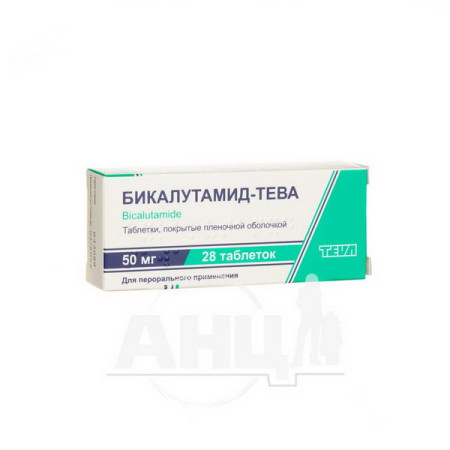Moxonidine-Farmak film-coated tablets 0.4 mg blister No. 30

Instructions Moxonidine-Farmak film-coated tablets 0.4 mg blister No. 30
Composition
active ingredient: moxonidine;
1 tablet contains moxonidine 0.2 mg or 0.3 mg or 0.4 mg;
excipients: lactose monohydrate, povidone, anhydrous lactose, crospovidone, magnesium stearate;
tablet shell: hypromellose, titanium dioxide (E 171), macrogol, red iron oxide (E 172), yellow iron oxide (E 172).
Dosage form
Film-coated tablets.
Main physicochemical properties:
0.2 mg – film-coated tablets, round, biconvex, pink in color.
0.3 mg – film-coated tablets, elongated, biconvex, pink in color, with a score on both sides (the score is made to facilitate swallowing and is not intended for division into two equal doses).
0.4 mg – film-coated tablets, round, biconvex, pink, with a score on one side (the score is made to facilitate swallowing and is not intended for division into two equal doses).
Pharmacotherapeutic group
Antihypertensive drugs. Imidazoline receptor agonists. ATC code C02A C05.
Pharmacological properties
Pharmacodynamics.
Moxonidine is an effective antihypertensive agent. Available experimental data indicate that the central nervous system (CNS) is the site of antihypertensive action of moxonidine. Moxonidine is a selective agonist of imidazoline receptors. These imidazoline-sensitive receptors are concentrated in the rostral ventrolateral medulla, an area considered to be the center of regulation of the peripheral sympathetic nervous system. Stimulation of imidazoline receptors contributes to a decrease in the activity of the sympathetic nervous system and reduces blood pressure.
Moxonidine differs from other sympatholytic antihypertensive agents in that it has a relatively low affinity for known α2-adrenoceptors compared to imidazoline receptors. As a result, sedation and dry mouth are rare with moxonidine.
In humans, the use of moxonidine leads to a decrease in peripheral vascular resistance with a subsequent decrease in blood pressure. The antihypertensive effect of moxonidine has been demonstrated in double-blind, placebo-controlled, randomized studies. Published data indicate that the use of an angiotensin II antagonist (AIIA) together with moxonidine in patients with arterial hypertension with left ventricular hypertrophy, while reducing the same level of blood pressure, achieved greater regression of left ventricular hypertrophy compared with the free combination of a thiazide and a calcium channel blocker.
In therapeutic studies lasting 2 months, moxonidine increased the insulin sensitivity index by 21% compared to placebo in patients with moderate hypertension, obesity and insulin resistance.
Pharmacokinetics.
Absorption. After oral administration, moxonidine is rapidly (time to peak plasma concentration is approximately 1 hour) and almost completely absorbed from the upper gastrointestinal tract. Absolute bioavailability is approximately 88%, indicating that there is no significant first-pass metabolism. Concomitant food intake does not affect the pharmacokinetics of moxonidine.
Distribution: The degree of plasma protein binding, determined in vitro, is approximately 7.2%.
Biotransformation: Only dehydrogenated moxonidine has been identified in human plasma samples. The pharmacodynamic activity of dehydrogenated moxonidine is approximately 1/10 that of moxonidine.
Excretion: Over a 24-hour period, 78% of the total dose of moxonidine is excreted in the urine as unchanged compound and 13% as dehydrogenated moxonidine. Other minor metabolites in the urine account for approximately 8% of the dose. Less than 1% is excreted in the feces. The half-lives of moxonidine and its metabolite are approximately 2.5 hours and 5 hours, respectively.
In patients with arterial hypertension, the pharmacokinetics of moxonidine did not differ significantly compared to healthy volunteers.
Changes in pharmacokinetics have been observed in the elderly, most likely due to a reduced rate of metabolism and/or slightly higher bioavailability. However, these changes are not considered clinically significant.
The elimination of moxonidine is largely dependent on creatinine clearance. In patients with moderate renal insufficiency (glomerular filtration rate (GFR) 30-60 ml/min), the steady-state plasma concentration and half-life are approximately 2 and 1.5 times higher than in patients with normal renal function (GFR > 90 ml/min). In patients with severe renal insufficiency (GFR < 30 ml/min), the steady-state plasma concentration and half-life are approximately 3 times higher. In these patients, no accumulation of moxonidine was observed after multiple administration. In patients with end-stage renal failure (GFR < 10 ml/min) on hemodialysis, the plasma AUC and half-life are approximately 6 and 4 times higher, respectively, compared to hypertensive patients with normal renal function. In patients with moderate renal insufficiency, the maximum plasma concentration of moxonidine is only 1.5-2 times higher.
Based on the above data, the dose of moxonidine for patients with renal insufficiency should be selected individually. Moxonidine is removed to a negligible extent during hemodialysis.
Preclinical safety data.
Non-clinical data reveal no special hazard for humans based on conventional studies of safety pharmacology, chronic toxicity, genotoxicity, carcinogenic potential and reproductive toxicity.
Animal studies have shown toxic effects on embryonal development at maternally toxic doses. Reproductive toxicity studies have shown no effects on fertility or teratogenic potential. Toxic effects on embryonal development have been observed in rats at doses ≥ 9 mg/kg/day and in rabbits at doses above 0.7 mg/kg/day. In peri- and postnatal development studies in rats, effects on development and viability have been observed at doses ≥ 3 mg/kg/day.
Indication
Arterial hypertension.
Contraindication
Hypersensitivity to the active substance or to any component of the drug.
Sick sinus syndrome.
Bradycardia (at rest – below 50 beats/min).
2nd and 3rd degree AV block.
Heart failure.
Interaction with other medicinal products and other types of interactions
Simultaneous use of the drug with other antihypertensive agents leads to an additive effect.
Since tricyclic antidepressants may reduce the effectiveness of centrally acting antihypertensive drugs, the concomitant administration of these drugs with moxonidine is not recommended.
Moxonidine may enhance the sedative effect of tricyclic antidepressants (simultaneous administration should be avoided), tranquilizers, alcohol, sedatives and hypnotics.
The drug moderately increases cognitive impairment in patients receiving lorazepam. Moxonidine may enhance the sedative effect of benzodiazepines when used concomitantly.
Moxonidine is eliminated by tubular excretion. Interactions with other agents eliminated by tubular excretion cannot be excluded.
Application features
During the post-marketing period, cases of atrioventricular block of varying severity have been reported in patients taking moxonidine. Therefore, a causal role of moxonidine in delaying atrioventricular conduction cannot be completely excluded. Therefore, caution is recommended when treating patients with a predisposition to the development of atrioventricular block.
Moxonidine should be used with extreme caution in patients with first-degree atrioventricular block to avoid bradycardia. Moxonidine should not be used in patients with third-degree atrioventricular block (see section 4.3).
Moxonidine should be used with caution in patients with severe ischemic heart disease or unstable angina, as experience with the drug in such patients is limited.
Caution is advised when using moxonidine in patients with impaired renal function, as moxonidine is mainly excreted by the kidneys. In such patients, careful dose titration is recommended, especially at the beginning of therapy. Treatment should be initiated with a dose of 0.2 mg/day; the dose may be increased to a maximum of 0.4 mg/day in patients with moderate renal impairment (GFR > 30 ml/min but < 60 ml/min) and to a maximum of 0.3 mg/day in patients with severe renal impairment (GFR < 30 ml/min), if clinically indicated and well tolerated.
If Moxonidine-Farmak is used in combination with a β-blocker and both drugs need to be discontinued, the β-blocker should be discontinued first, and then Moxonidine-Farmak after a few days.
To date, no withdrawal effects on blood pressure have been observed after discontinuation of moxonidine. However, abrupt discontinuation of moxonidine therapy is not recommended; instead, the dose should be gradually reduced over a period of two weeks.
Patients with rare hereditary problems of galactose intolerance, the Lapp lactase deficiency or glucose-galactose malabsorption should not take this medicine.
Use during pregnancy or breastfeeding
There are no adequate data on the use of moxonidine in pregnant women. Animal studies have shown embryotoxic effects. The potential risk to humans is unknown. Moxonidine should not be used during pregnancy unless clearly necessary.
Breastfeeding period.
Moxonidine passes into breast milk, so it should not be used during breastfeeding. If therapy with moxonidine is considered absolutely necessary, breastfeeding should be discontinued.
The ability to influence the reaction speed when driving or working with other mechanisms
Studies on the effect of the drug on the ability to drive or operate machinery have not been conducted. Cases of drowsiness and dizziness have been recorded when using the drug. This should be taken into account when performing the above actions.
Method of administration and doses
The standard starting dose of moxonidine is 0.2 mg per day. The maximum single dose is 0.4 mg. The maximum daily dose is 0.6 mg, administered in 2 divided doses. The dose should be adjusted individually, depending on the patient's response.
Moxonidine-Farmak can be taken regardless of meals, with a small amount of liquid.
For patients with moderate or severe renal impairment, the initial dose of moxonidine is 0.2 mg per day. If necessary and well tolerated, the dose may be increased to 0.4 mg per day for patients with moderate renal impairment and to 0.3 mg per day for patients with severe renal impairment (see section 4.4).
For patients on hemodialysis, the initial dose of Moxonidine-Pharmax is 0.2 mg per day. If necessary and if the drug is well tolerated, the dose can be increased to 0.4 mg per day.
Children.
Moxonidine-Farmak is not recommended for use in children due to insufficient data on the safety and efficacy of the drug in this group.
Overdose
Symptoms of overdose.
In isolated cases, overdose of moxonidine, even at a dose of 19.6 mg taken at a time, did not lead to a fatal outcome. Signs and symptoms of overdose include headache, sedation, drowsiness, hypotension, dizziness, asthenia, bradycardia, dry mouth, vomiting, fatigue, upper abdominal pain. In case of severe overdose, careful monitoring for impaired consciousness and respiratory depression is recommended. Based on studies of high doses of the drug in animals, transient hypertension, tachycardia and hyperglycemia can additionally be expected.
Necessary measures in case of overdose.
Specific antidotes are unknown. In case of hypotension, dopamine and plasma exchange solutions are recommended to maintain hemocirculation. Atropine can be used if bradycardia occurs.
α-Adrenoceptor antagonists may reduce or eliminate the paradoxical hypertensive effects of moxonidine overdose.
Side effects
The most common side effects of moxonidine include dry mouth, dizziness, asthenia, and drowsiness. These symptoms often decrease after the first few weeks of treatment.
The following adverse reactions, grouped by body system class and distributed by frequency, were observed during placebo-controlled clinical trials in 886 patients who used moxonidine: very common (≥ 1/10), common (≥ 1/100, < 1/10), uncommon (≥ 1/1000, < 1/100).
| Organ systems | Very often | Often | Infrequently |
| From the psyche | insomnia | nervousness | |
| From the nervous system | headache*, dizziness/vertigo, drowsiness | faint* | |
| From the side of the organs of hearing and labyrinth | tingle | ||
| Cardiovascular system | bradycardia, hypotension* (including orthostatic hypotension) | ||
| Gastrointestinal tract | dry mouth | diarrhea, nausea/vomiting/dyspepsia | |
| Skin and subcutaneous tissue disorders | rash, itching | angioedema | |
| Musculoskeletal and connective tissue disorders | back pain | neck pain | |
| General disorders and administration site conditions | asthenia | edema |
* Frequency not increased compared to placebo.
Expiration date
2 years.
Storage conditions
Store in the original packaging to protect from light at a temperature not exceeding 30 ° C. Keep out of the reach of children.
Packaging
10 tablets in a blister, 3 blisters in a cardboard pack.
Vacation category
According to the recipe.
Producer
Saneka Pharmaceuticals JSC.
Location of the manufacturer and address of its place of business.
Nitra 100, 920 27 Hlohovec, Slovak Republic.
Applicant.
JSC "Farmak".
Location of the applicant. Ukraine, 04080, Kyiv, Kyrylivska St., 63.
There are no reviews for this product.
There are no reviews for this product, be the first to leave your review.
No questions about this product, be the first and ask your question.















